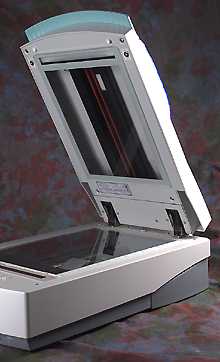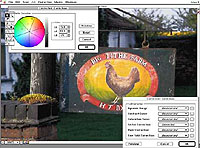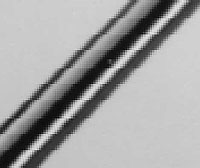 So why buy it? Is it priced to selli at a premium to an existing market
on the basis of Linotype-Hell's reputation?
So why buy it? Is it priced to selli at a premium to an existing market
on the basis of Linotype-Hell's reputation?
 So why buy it? Is it priced to selli at a premium to an existing market
on the basis of Linotype-Hell's reputation?
So why buy it? Is it priced to selli at a premium to an existing market
on the basis of Linotype-Hell's reputation?
Photographers and labs are a new target market for this scanner, which sells at just under £3,500 list price including a tranny scanning lid and Linocolor Lite 4 software. Linotype-Hell can not sell through their efficient, established printing and repro industry channels to this new market, and reach it through distributors like Camelot and Jigsaw.
These stockists are going to have a hard time selling Saphir at this price against Agfa, Nikon, Umax, Epson and Microtek. Every photographer with a photo-capable computer plans to get a scanner in the next two years - we know that from our research.
So why should they - that's YOU - buy this one?
The answer lies not in the scanner, but in the software. Linocolor Lite 4 is a dongle-protected superapp based on expert know-how. It's a £2,000 program bundled with a £1,500 scanner. Linotype know, however, that people hate paying for software. They are much happier thinking that they are paying for superior precision equipment and getting the software thrown in.
We have to assume our readers are more intelligent than that, and want to be correctly informed. Buy this scanner and use the Photoshop plug-in, and you are wasting two grand. Use Linocolor Lite 4 alongside Photoshop, read the manual, learn about colour management through the literature and training CD-ROM provided, and you give yourself a substantial advantage over your lesser competitors who can't be bothered to deal with its bewildering settings, controls and functions.
 If the Saphir is an enhanced PowerLook, as Linotype claim, it's hard to
see how. I think the modification is limited to a new casing, specific
performance criteria which have to be met, and some firmware which gives
it its own identity and a command set compatible with Linocolor.
If the Saphir is an enhanced PowerLook, as Linotype claim, it's hard to
see how. I think the modification is limited to a new casing, specific
performance criteria which have to be met, and some firmware which gives
it its own identity and a command set compatible with Linocolor.
In the process, the Saphir gets to look pretty good. The design is an enhancement over the original. It also loses some functionality, in that neither the Photoshop plug-in nor Linocolor make use of the full scanning area, restricting it to A4. This is frustrating as Linocolor allows multiple original batch scanning, and though you can put three typical prints on the scanner, the operating area will only cover two and half.
Saphir is also slower than its Umax counterpart; it has more complex calibration, and Linocolor converts raw scanner RGB into printer-specific final CMYK on the fly.
The key words here are 'raw' and 'final'. Saphir is a 10-bit scanner (1,024 gradations per channel) and most originals will scan to a brightness and contrast range which is adequate for reproduction. A series of controlled changes to this raw file can, however, make all the difference, matching it perfectly to a final output device such as a film recorder, dye sublimation printer or litho press.
These changes can include interpolation (changing resolution and file size), gamma adjustment (midtone density enhancement), shadow and highlight settings, colour correction and gamut remapping, change of data format, and edge enhancement to improve visual sharpness.
The key to the Saphir's quality is that each scanner (hardware) is very tightly quality controlled so that its raw scan is predictable. Using the Linocolor ColorSync 2.0 profile for the scanner, Lincolor Lite can then handle all the necessary corrections as the scan comes in to the computer.
What you get is a final scan, not a starting point for Photoshop enhancement and correction and later file conversion to CMYK.
 There is not enough space here to explain Linocolor Lite 4 - it would
involve printing a crash course in colour science. Linotype's literature
provides this for anyone willing to learn.
There is not enough space here to explain Linocolor Lite 4 - it would
involve printing a crash course in colour science. Linotype's literature
provides this for anyone willing to learn.
The software, which dislikes virtual memory and utilities like RAMDoubler, requires a hefty machine to run but then goes like stink. Get past the German scanning dialogue-box design and you find an exceptionally productive environment which rarely needs extra Photoshop work. It even has a pixel-duplicating tool which does the same as Photoshop's invaluable Rubber Stamp Cloner, letting you remove dust, scratches and flaws quickly and invisibly. It also has omissions, such as no provision for rescaling or resampling the acquired image.
Comparing Saphir Photoshop plug-in scans with direct Linocolor scans,
it's easy to see why there is a price difference. The plug-ins and
Photoshop produce stepped  aliasing of image detail if you don't stick to
scanning at the optical resolution of the unit (divisions of 600 x
1200dpi). Linocolor Lite will give you any size of scan you want, unsharp
masked, without a trace of interpolation 'damage'. It will blow up
rollfilm trannies to full page with grain sharpness, normally beyond the
capacity of a flatbed scanner. Our last issue's cover proved this.
aliasing of image detail if you don't stick to
scanning at the optical resolution of the unit (divisions of 600 x
1200dpi). Linocolor Lite will give you any size of scan you want, unsharp
masked, without a trace of interpolation 'damage'. It will blow up
rollfilm trannies to full page with grain sharpness, normally beyond the
capacity of a flatbed scanner. Our last issue's cover proved this.
Colour adjustment, selective masking and afterwork are all much easier than in Photoshop. The reason for this is Linotype's own LCH 'human interface' - you can select and adjust colours using Lightness, Chroma and Hue. Most photographers find it a real problem getting to grips with the idea that Hue is expressed an as angle in degrees, but you just have to learn what LCH is about. Once the idea sinks in, using this instead of LAB, RGB or CMYK becomes intuitive.
Linotype's LAB-LH file format covers more colours than Photoshop's LAB core format. Unlike RGB or CMYK, LAB is evenly spaced visually, a benefit which any darkroom colour printer who has encountered the exposure correction difference between a 10CC yellow shift and 10CC cyan will understand. In Linocolor, similar numeric shifts in any direction have visually comparable effects on colour balance.
To export a Linocolor file to Photoshop involves squashing the information it contains down into Photoshop's LAB format, so Linotype provide import and export plug-ins to handle this.
Readers who know Photoshop will comment that LCH sounds just like HSB - the Hue, Saturation and Brightness controls of Photoshop. I can only comment that Linocolor's controls are far superior. It was easy to select a coloured area in a photograph using only the LCH parameters, and change its colour entirely. Doing so in Photoshop has always been a tedious process of extending and trimming the selection, watching as it failed to select all of an object then, when given a small adjustment, selected half the picture. Linocolor Lite 4 handled this kind of selective adjustment, vital in much digital product photography, with speed and accuracy I have only previously seen on a Barco Creator.
The screen display, in calibrated monitor RGB controlled by ColorSync 2.0, was as good as Photoshop. It should be - Linotype are the co-originators of ColorSync 2.0.
Final CMYK files were just what they should have been for printing - it was not possible to fault them alongside the best Photoshop CMYK we have been able to set up, or PageMaker 6.0's use of the Kodak Colour Management System.
My only worry for the future is that Linotype-Hell have, with Apple, created in ColorSync 2.0 a method for managing colour which is competing with Kodak's. The Kodak system may be friendlier towards those who need to keep files in RGB to re-purpose or archive. There are many other reasons why generic RGB is a useful image storage format, rather than LAB or printer-specific CMYK. Linocolor Lite can of course create RGB files, but its strength lies in its native LAB-LH format and the final CMYK device-specific exported file.
At the same time, if we don't cover these issues, no-one else is going to, and photographers will be unaware that there is a growing creative and technical business community to whom these terms are the substance of their daily work.
Any photographer or lab buying a Saphir scanner from Linotype will be able to get to grips with this stuff. If you just buy yourself a £300 scanner for your PC and do everything by judging what your screen image looks like in PaintShop Pro, you'll have fun, but you will be like a photographer today who has no idea what filmspeed and lens aperture mean or why Fujichrome 64T is different from Kodak Gold II.
Tomorrow's photographer, like today's graphic artist or litho printer, will have to understand colour space, device-independent colour, colour management systems, image file formats, gamuts and all these things which have previously been looked after by backroom experts.
The Saphir is probably no better hardware-wise than most scanners costing around £1,500 with a tranny lid. Combined with Linocolor Lite 4, however, it will not mislead the novice and can in the process turn a good learner into an expert.
Linocolor software costs over £2,000 separately and can only be used with Linotype-Hell devices anyway. The Saphir package is the cheapest way to find yourself working with the same software your brochure printer got with their £300,000 repro system - at a hundredth of the price.
David Kilpatrick